Addressing Energy Poverty in the Energy Community: Assessment of Energy, Environmental, Economic, and Social Benefits for an Italian Residential Case Study
Abstract
1. Introduction
- (i)
- The assessment of the energy, environmental, economic, and social benefits of a photovoltaic-based REC located in the south of Italy, compared with the case in which an REC does not exist, in order to evaluate the mitigation of EP.
- (ii)
- The definition of a new social indicator to measure the potential of RECs in the mitigation of energy poverty.
2. Materials and Methods
2.1. Buildings and Users’ Characterization
2.2. Energy Conversion Systems
- R#1: three reversible air-to-air heat pumps (EHPR#1_1/2/3) were installed outdoors to meet the space cooling load of the R#1 user during the summer period. They have a rated cooling capacity of 5.2, 2.6, and 2.6 kWCo, respectively, while the nominal energy efficiency ratio (EER) is 3.68, 4.0, and 4.0, respectively [56].
- R#2: three reversible air-to-air heat pumps (EHPR#2_1/2/3) were installed outdoors to cover the space cooling load of the R#2 user during the summer period. They have a rated cooling capacity of 4.3, 2.5, and 2.5 kWCo, respectively, while the nominal EER is 3.3, 3.6, and 3.6, respectively [57].
- R#3: two reversible air-to-air heat pumps (EHPR#3_1/2) were installed outdoors to meet the space cooling load of the R#2 user during the summer period and the one-time heating demand, such as during the morning in the winter period. They have a rated cooling capacity of 4.2 and 3.4 kWCo, respectively, and the nominal EER is 3.75 for both of them. In addition, the heating capacity of EHPR#3_1/2 is 4.0 and 5.4 kWth, respectively, while the nominal coefficient of performance (COP) is equal to 4.04 and 4.12, respectively [58].
2.3. Model Description
2.4. Methodology
2.4.1. Energy Analysis
2.4.2. Environmental Analysis
2.4.3. Socio-Economic Analysis
3. Results and Discussion
4. Conclusions
Author Contributions
Funding
Institutional Review Board Statement
Informed Consent Statement
Data Availability Statement
Acknowledgments
Conflicts of Interest
Nomenclature
| d | RES local self-consumption (-) |
| E | Energy demand (kWh/y)—(MWh/y) |
| E(θ) | Energy demand (kWh)—(MWh) |
| EER | Energy efficiency ratio (-) |
| f | Percentage of PV investment cost covered by economic mechanism support (%) |
| HDD | Heating degree days (-) |
| I | Income (EUR/y) |
| ISEE | Equivalent economic situation indicator (EUR/y) |
| OC | Operating cost (EUR/y) |
| c | Unit price (EUR/kWh)- (EUR/m3) |
| p | Economic incentive for self-consumption REC (EUR/MWh) |
| s | RES load covered (-) |
| CO2 emission (kgCO2/y) | |
| SPB | Simple payback (y) |
| 10% | Socio-economic index (-) |
| Subscript | |
| Co | Cooling |
| El | Electric |
| PG | Power grid |
| pr | Primary |
| PV | Photovoltaic |
| R | Residential |
| REC | Renewable energy community |
| SU | Single user |
| Sell | Sell |
| Sh | Shared |
| Th | Thermal |
| Greek Symbol | |
| α | Electricity emission factor (kgCO2/kWh) |
| Efficiency (-) | |
| Acronyms | |
| ARERA | Energy and Environmental Italian Authority |
| CO2 | Carbon dioxide |
| EHP | Electric heat pump |
| EU | European union |
| EP | Energy poverty |
| IEMD | Internal Electricity Market Directive |
| LIHC | Low income high costs |
| M/2 | Low absolute energy expenditure |
| 2M | High share of energy expenditure in income |
| PG | Italian electric grid |
| POD | Point of delivery |
| PV | Photovoltaic panel |
| R | Residential user |
| REC | Renewable energy community |
| REDII | Renewable Energy Directive |
| RES | Renewable energy source |
| PG | Power grid |
| PS | Primary substation |
| SU | Single user |
References
- European Union. Energy Poverty Observatory. Towards an Inclusive Energy Transition in the European Union: Confronting Energy Poverty Amidst a Global Crisis. 2020. Available online: https://op.europa.eu/en/publication-detail/-/publication/4a440cf0-b5f5-11ea-bb7a-01aa75ed71a1/language-en (accessed on 12 July 2022).
- Carfora, A.; Scandurra, G.; Thomas, A. Forecasting the COVID-19 effects on energy poverty across EU member states. Energy Policy 2022, 161, 112597. [Google Scholar] [CrossRef] [PubMed]
- World Bank. Global Economic Prospects Global Economic Prospects; World Bank Publications: Washington, DC, USA, 2020. [Google Scholar] [CrossRef]
- EPEE (European Fuel Poverty and Energy Efficiency). Diagnosis of Causes and Consequences of C in Belgium, France, Italy, Spain and United Kingdom (WP2-Deliverable 5); Dixit Productions: Boulogne, France, 2009. [Google Scholar]
- BPIE (Buildings Performance Institute Europe). Alleviating Fuel Poverty in the EU. Investing in Home Renovation, a Sustainable and Inclusive Solution; BPIE: Brussels, Belgium, 2014. [Google Scholar]
- Thomson, H.; Snell, C.; Liddell, C. Fuel poverty in the European Union: A concept in need of definition? People Place Policy 2016, 10, 5–24. [Google Scholar] [CrossRef]
- European Commission. Bringing Energy Poverty Research into Local Practice: Exploring Subnational Scale Analyses Energy Poverty Advisory Hub, February 2022. Available online: https://energy-poverty.ec.europa.eu/system/files/2022-03/EPAH_Bringing%20Energy%20Poverty%20Research%20into%20local%20practice_final.pdf (accessed on 25 October 2022).
- Bouzarovski-Buzar, S. Energy Poverty in the EU: A Review of the Evidence. DG Regio Workshop on Cohesion Policy Investing in Energy Efficiency in Buildings; European Union: Brussels, Belgium, 2011. [Google Scholar]
- The Lancet Regional Health—Europe. The regional and global impact of the Russian invasion of Ukraine. Lancet Reg. Health Eur. 2022, 15, 100379. [Google Scholar] [CrossRef] [PubMed]
- Rapporto 2021 su Povertà ed Esclusione Sociale in Italia. Italian Document. Available online: https://archivio.caritas.it/caritasitaliana/allegati/9651/Rapporto_Caritas_poverta_2021_oltre_ostacolo.pdf (accessed on 25 October 2022).
- Orzechowski, A.; Bombol, M. Energy Security, Sustainable Development and the Green Bond Market. Energies 2022, 15, 6218. [Google Scholar] [CrossRef]
- Ferrer, R.; Shahzad, S.J.H.; Soriano, P. Are green bonds a different asset class? Evidence from time-frequency connectedness analysis. J. Clean. Prod. 2021, 292, 125988. [Google Scholar] [CrossRef]
- ENEA. Action Plan for the Energy Efficiency; ENEA: Roma, Italy, 2017. [Google Scholar]
- Corrado, V.; Ballarini, I. Refurbishment trends of the residential building stock: Analysis of a regional pilot case in Italy. Energy Build. 2016, 132, 91–106. [Google Scholar] [CrossRef]
- European Commission Clean Energy for All Europeans Package. 2019. Available online: https://ec.europa.eu/energy/topics/energy-strategy/clean-energy-all-europeans_en (accessed on 13 January 2022).
- Commission Recommendation (EU) 2020/1563 of 14 October 2020 on Energy Poverty. Available online: https://eur-lex.europa.eu/legal-content/EN/TXT/?uri=CELEX:32020H1563&qid=1606124119302 (accessed on 14 July 2022).
- Directive (EU) 2018/2001 of the European Parliament and of the Council of 11 December 2018 on the Promotion of the Use of Energy from Renewable Sources (Recast). 2018. Available online: https://eur-lex.europa.eu/legal-content/EN/TXT/?uri=uriserv:OJ.L_.2018.328.01.0082.01.ENG (accessed on 14 July 2022).
- Hanke, F.; Guyet, R.; Feenstra, M. Do renewable energy communities deliver energy justice? Exploring insights from 71 European cases. Energy Res. Soc. Sci. 2021, 80, 102244. [Google Scholar] [CrossRef]
- Italian Revenue Agency, Fiscal Incentives for Energy Saving. 2019. Available online: https://agenziaentrate.gov.it/portale/web/guest/cittadini/agevolazioni (accessed on 7 November 2022). (In Italian)
- Italian Revenue Agency, Guidlines to Superbonus 110%. 2020. Available online: https://agenziaentrate.gov.it/portale/web/guest/superbonus-110%25 (accessed on 7 November 2022). (In Italian)
- Ceglia, F.; Marrasso, E.; Pallotta, G.; Roselli, C.; Sasso, M. The State of the Art of Smart Energy Communities: A Systematic Review of Strengths and Limits. Energies 2022, 15, 3462. [Google Scholar] [CrossRef]
- Luz, P.G.; Silva, R.A. Modeling Energy Communities with Collective Photovoltaic Self-Consumption: Synergies between a Small City and a Winery in Portugal. Sustainability 2021, 14, 323. [Google Scholar] [CrossRef]
- Ceglia, F.; Marrasso, E.; Roselli, C.; Sasso, M. Small Renewable Energy Community: The Role of Energy and Environmental Indicators for Power Grid. Sustainability 2021, 13, 2137. [Google Scholar] [CrossRef]
- Felice, A.; Rakocevic, L.; Peeters, L.; Messagie, M.; Coosemans, T.; Camargo, L.R. Renewable energy communities: Do they have a business case in Flanders? Appl. Energy 2022, 132, 119419. [Google Scholar] [CrossRef]
- Petrichenko, L.; Sauhats, A.; Diahovchenko, I.; Segeda, I. Economic Viability of Energy Communities versus Distributed Prosumers. Sustainability 2022, 14, 4634. [Google Scholar] [CrossRef]
- Minuto, F.D.; Lazzeroni, P.; Borchiellini, R.; Olivero, S.; Bottaccioli, L.; Lanzini, A. Modeling technology retrofit scenarios for the conversion of condominium into an energy community: An Italian case study. J. Clean. Prod. 2021, 282, 124536. [Google Scholar] [CrossRef]
- Fina, B.; Schwebler, M.; Monsberger, C. Different Technologies’ Impacts on the Economic Viability, Energy Flows and Emissions of Energy Communities. Energies 2022, 14, 4993. [Google Scholar] [CrossRef]
- Schram, W.; Louwen, A.; Lampropoulos, I.; van Sark, W. Comparison of the Greenhouse Gas Emission Reduction Potential of Energy Communities. Energies 2019, 12, 4440. [Google Scholar] [CrossRef]
- Fleischhacker, A.; Lettner, G.; Schwabeneder, D.; Auer, H. Portfolio optimization of energy communities to meet reductions in costs and emissions. Energy 2019, 173, 1092–1105. [Google Scholar] [CrossRef]
- Ceglia, F.; Macaluso, A.; Marrasso, E.; Sasso, M.; Vanoli, L. Modelling of polymeric shell and tube heat exchangers for low-medium temperature geothermal applications. Energies 2020, 13, 2737. [Google Scholar] [CrossRef]
- Yamashita, D.Y.; Vechiu, I.; Gaubert, J.P. A review of hierarchical control for building microgrids. Renew. Sustain. Energy Rev. 2020, 118, 109523. [Google Scholar] [CrossRef]
- Jank, R. Annex 51: Case studies and guidelines for energy efficient communities. Energy Build. 2017, 154, 529–537. [Google Scholar] [CrossRef]
- Shaukat, N.; Ali, S.M.; Mehmood, C.A.; Khan, B.; Jawad, M.; Farid, U.; Ullah, Z.; Anwar, S.M.; Majid, M. A survey on consumers empowerment, communication technologies, and renewable generation penetration within Smart Grid. Renew. Sustain. Energy Rev. 2018, 81, 1453–1475. [Google Scholar] [CrossRef]
- Jafari, A.; Khalili, T.; Ganjehlou, H.G.; Bidram, A. Optimal integration of renewable energy sources, diesel generators, and demand response program from pollution, financial, and reliability viewpoints: A multi-objective approach. J. Clean. Prod. 2020, 247, 119100. [Google Scholar] [CrossRef]
- Sousa, T.; Soares, T.; Pinson, P.; Moret, F.; Baroche, T.; Sorin, E. Peer-to-peer and community-based markets: A comprehensive review. Renew. Sustain. Energy Rev. 2019, 104, 367–378. [Google Scholar] [CrossRef]
- Cuesta, M.A.; Castillo-Calzadilla, T.; Borges, C.E. A critical analysis on hybrid renewable energy modelling tools: An emerging opportunity to include social indicators to optimise systems in small communities. Renew. Sustain. Energy Rev. 2020, 122, 109691. [Google Scholar] [CrossRef]
- Knox, S.; Hannon, M.; Stewart, F.; Ford, R. The (in)justices of smart local energy systems: A systematic review, integrated framework, and future research agenda. Energy Res. Soc. Sci. 2022, 83, 102333. [Google Scholar] [CrossRef]
- Hanke, F.; Lowitzsch, J. Empowering Vulnerable Consumers to Join Renewable Energy Communities—Towards an Inclusive Design of the Clean Energy Package. Energies 2020, 13, 1615. [Google Scholar] [CrossRef]
- Ambole, A.; Koranteng, K.; Njoroge, P.; Luhangala, D.L. A Review of Energy Communities in Sub-Saharan Africa as a TransitionPathway to Energy Democracy. Sustainability 2021, 13, 2128. [Google Scholar] [CrossRef]
- Ehnberg, J.; Ahlborg, H.; Hartvigsson, E. Approach for flexible and adaptive distribution and transformation design in ruralelectrification and its implications. Energy Sustain. Dev. 2020, 54, 101–110. [Google Scholar] [CrossRef]
- Rademaekers, K.; Yearwood, J.; Ferreira, A.; Pye, S.; Hamilton, I.; Agnolucci, P.; Grover, D.; Karásek, J.; Anisimova, N. Selecting Indicators to Measure Energy Poverty. Trinomics. 2016. Available online: https://trinomics.eu/wp-content/uploads/2016/06/Selecting-Indicators-to-Measure-Energy-Poverty.pdf (accessed on 26 October 2022).
- Ceglia, F.; Marrasso, E.; Roselli, C.; Sasso, M. Time-evolution and forecasting of environmental and energy performance of electricity production system at national and at bidding zone level. Energy Convers. Manag. 2022, 265, 115772. [Google Scholar] [CrossRef]
- Fichera, A.; Marrasso, E.; Sasso, M.; Volpe, R. Energy, Environmental and Economic Performance of an Urban Community Hybrid Distributed Energy System. Energies 2020, 13, 2524. [Google Scholar] [CrossRef]
- EPAH. Indicators & Data. Energy Poverty Advisory Hub. 2022. Available online: https://energy-poverty.ec.europa.eu/energy-poverty-observatory/indicators_en (accessed on 26 October 2022).
- Department of Energy and Climate Change (DECC). Annual Fuel Poverty Statistics Report England. National Statistics of England. 2016. Available online: https://assets.publishing.service.gov.uk/government/uploads/system/uploads/attachment_data/file/637430/Annual_Fuel_Poverty_Statistics_Report_2016_-_revised_26.04.2017.pdf (accessed on 26 October 2022).
- Siksnelyte-Butkiene, I.; Streimikiene, D.; Lekavicius, V.; Balezentis, T. Energy poverty indicators: A systematic literature review and comprehensive analysis of integrity. Sustain. Cities Soc. 2021, 67, 102756. [Google Scholar] [CrossRef]
- Boardman, B. Fuel Poverty: From Cold Homes to Affordable Warmth; Belhaven Press: London, UK, 1991; 267p, ISBN 1852931396. [Google Scholar]
- Corrado, V.; Ballarini, I.; Corgnati, S.P. Building Typology Brochure—Italy. 2014. Available online: https://episcope.eu/fileadmin/tabula/public/docs/brochure/IT_TABULA_TypologyBrochure_POLITO.pdf (accessed on 14 July 2022).
- Personal Data about Energy Consumption on Enel Distribution. Available online: https://www.e-distribuzione.it/servizi.html (accessed on 14 July 2022).
- UNI TS 11300-2. Energy Performance of Buildings. In Part 2: Evaluation of Primary Energy Need and System Efficiencies for Space Heating and Domestic Hot Water Production; UNI, Ente Nazionale di Unificazione: Milan, Italy, 2008; Available online: https://tuxdoc.com/download/uni-ts-11300-2-3_pdf (accessed on 14 July 2022).
- ENI. Personal Data about Energy Consumption. Available online: https://www.eni.com/it-IT/area-riservata.html (accessed on 14 July 2022).
- ITALGAS. Personal Data about Energy Consumption. Available online: https://clienti.italgas.it/clienti/login.action (accessed on 14 July 2022).
- d.lgs, 112/2020/R/eel, Italy. Guidelines for the Regulation of Economic Items Relating to Electricity Subject to Collective Self-Consumption or Sharing within the Renewable Energy Community. (Orientamenti per la Regolazione Delle Partite Economiche Relative All’energia Elettrica Oggetto di Autoconsumo Collettivo o di Condivisione Nell’ambito di Comunità di Energia Rinnovabile, in Italian). Available online: https://www.arera.it/it/docs/20/112-20.htm (accessed on 18 July 2022).
- RIELLO. Technical Data—Sheet Boiler. Available online: https://www.riello.it/catalogo/caldaie?range=31BICGAERF (accessed on 30 July 2022).
- ARISTON. Technical Data—Sheet Boiler. Available online: https://www.ariston.com/it-it/prodotti/caldaie/condensazione (accessed on 30 July 2022).
- RIELLO. Technical Data—Sheet Air to Air Heat Pump. Available online: https://www.riello.it/catalogo/condizionamento?range=61ABEASWRT (accessed on 31 July 2022).
- MITSUBISHI. Technical Data—Sheet Air to Air Heat Pump. Available online: https://climatizzazione.mitsubishielectric.it/uploads/document/scheda_tecnica_5068.pdf (accessed on 31 July 2022).
- DAIKIN. Technical Data—Sheet Air to Air Heat Pump. Available online: https://www.daikin.it/it_it/cataloghi-e-app.html (accessed on 31 July 2022).
- KYOCERA. Technical Data—Sheet Photovoltaic. Available online: https://global.kyocera.com/prdct/solar/ (accessed on 31 July 2022).
- HOMER. Homer Energy, Citizen Manual of HOMER®Pro, Version 3.7; HOMER: Boulder, CO, USA, 2016.
- European Community. Photovoltaic Geographical Information System. Available online: https://re.jrc.ec.europa.eu/pvg_tools/en/#api_5.2 (accessed on 31 July 2022).
- MATLAB. MATLAB and Statistics Toolbox Release; MathWorks, Inc.: Natick, MA, USA, 2018. [Google Scholar]
- Ceglia, F.; Marrasso, E.; Rosselli, C.; Sasso, M. An innovative environmental parameter: Expanded Total Equivalent Warming Impact. Int. J. Refrig. 2021, 131, 980–989. [Google Scholar] [CrossRef]
- ARERA. Electricity Price Trend for the Typical Domestic Consumer in Greater Protection. Data of First Semester 2021. (Andamento del Prezzo Dell’energia Elettrica per il Consumatore Domestico Tipo in Maggior Tutela, in Italian). Available online: https://www.arera.it/it/dati/eep35.htm (accessed on 15 July 2022).
- ARERA. Minimum Renewable Energy Price. Available online: https://www.arera.it/it/elettricita/prezziminimi.htm (accessed on 15 July 2022).
- Ceglia, F.; Esposito, P.; Faraudello, A.; Marrasso, E.; Rossi, P.; Sasso, M. An energy, environmental, management and economic analysis of energy efficient system towards renewable energy community: The case study of multi-purpose energy community. J. Clean. Prod. 2022, 369, 133269. [Google Scholar] [CrossRef]
- IRENA. International Renewable Energy Agency, Renewable Power Generation Costs in 2019. 2020. Available online: https://www.irena.org/-/media/Files/IRENA/Agency/Publication/2020/Jun/IRENA_Power_Generation_Costs_2019.pdf%20tabella (accessed on 31 October 2022).
- GSE. Renewable Sell Price. Available online: https://www.gse.it/servizi-per-te/fotovoltaico/ritiro-dedicato/documenti (accessed on 31 October 2022).





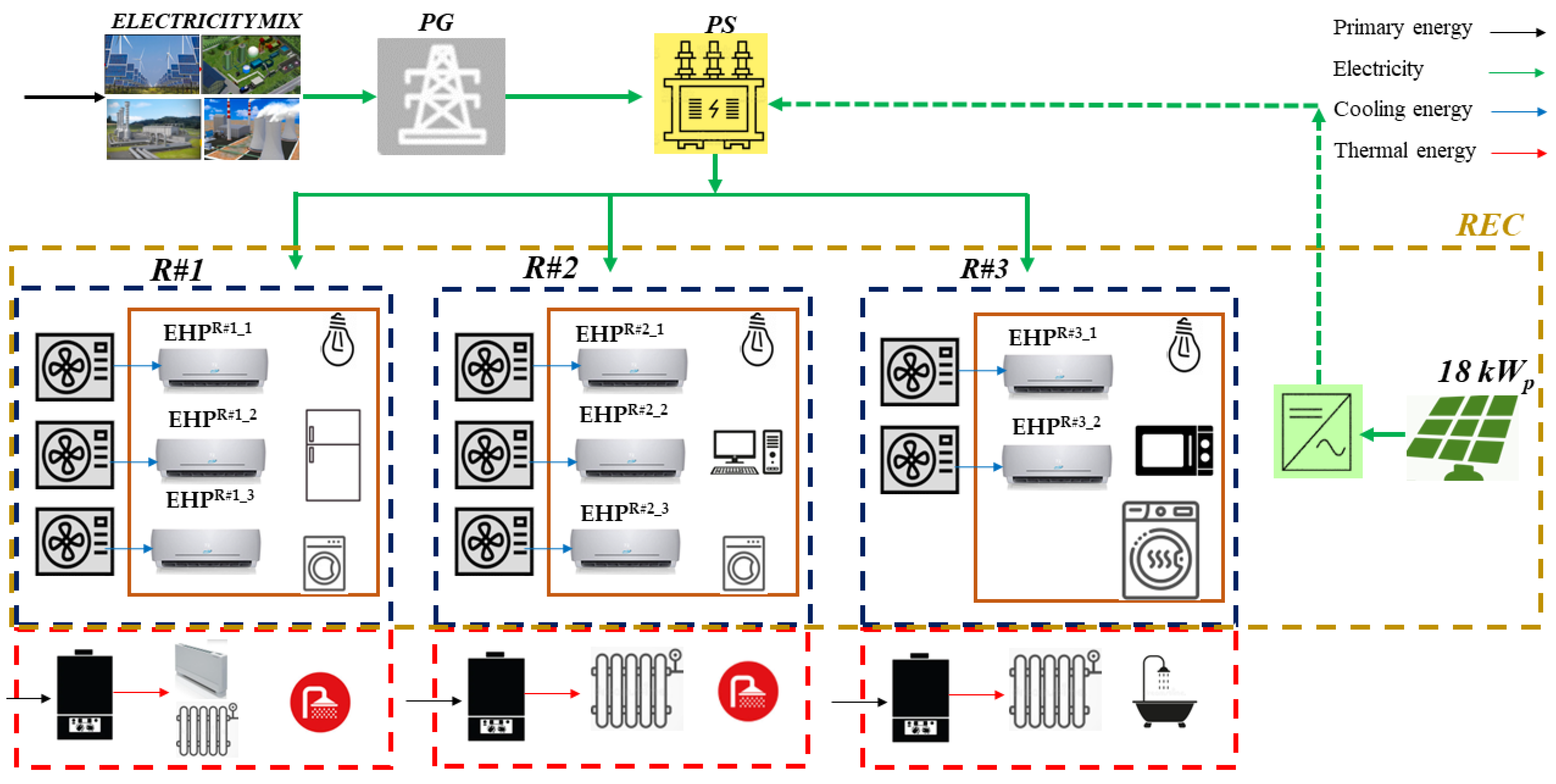
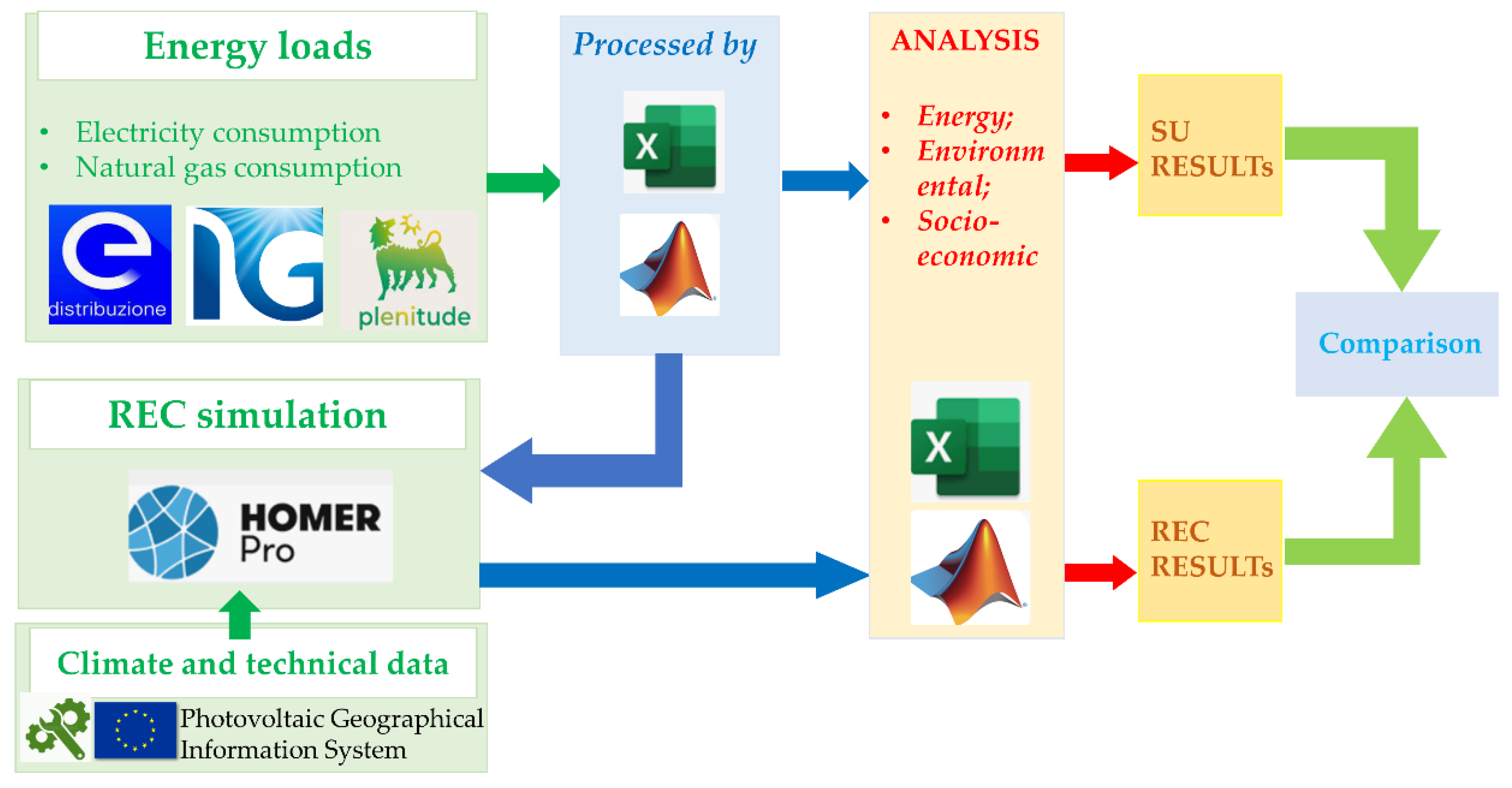


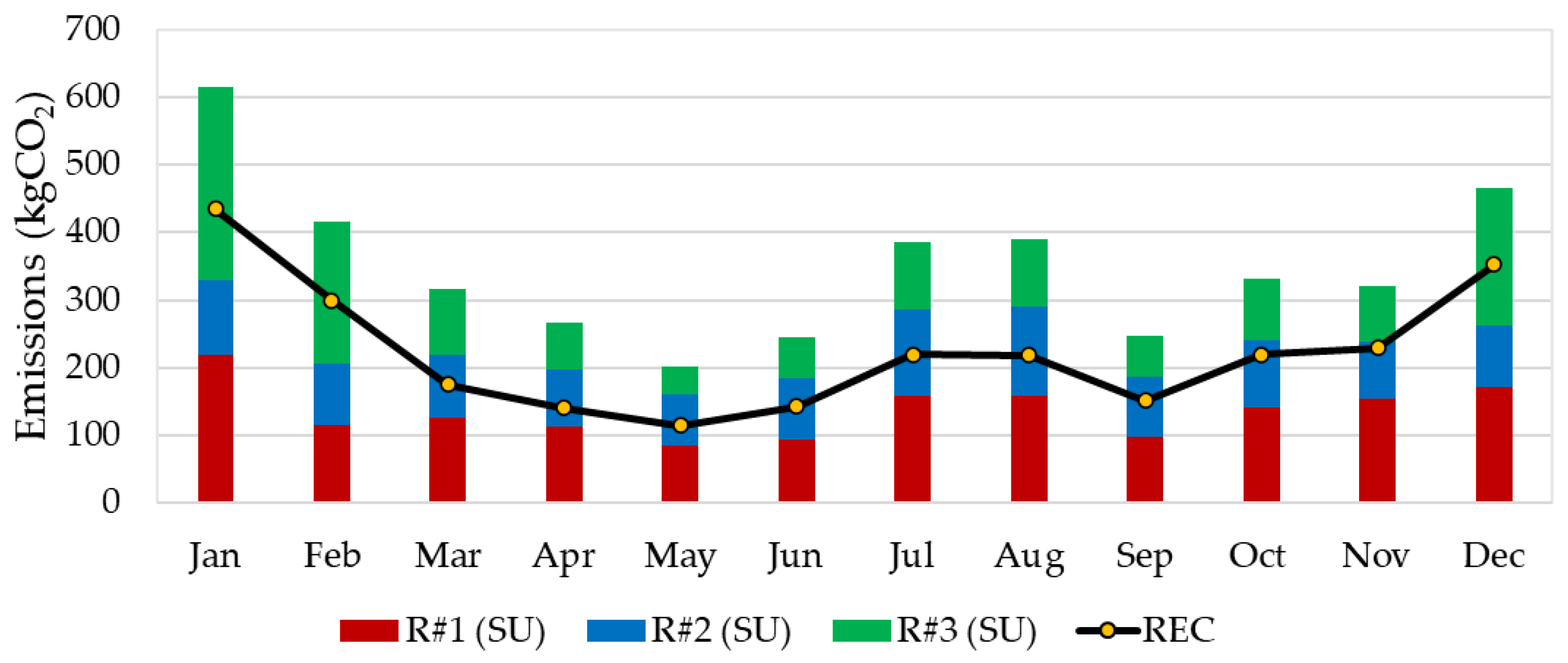


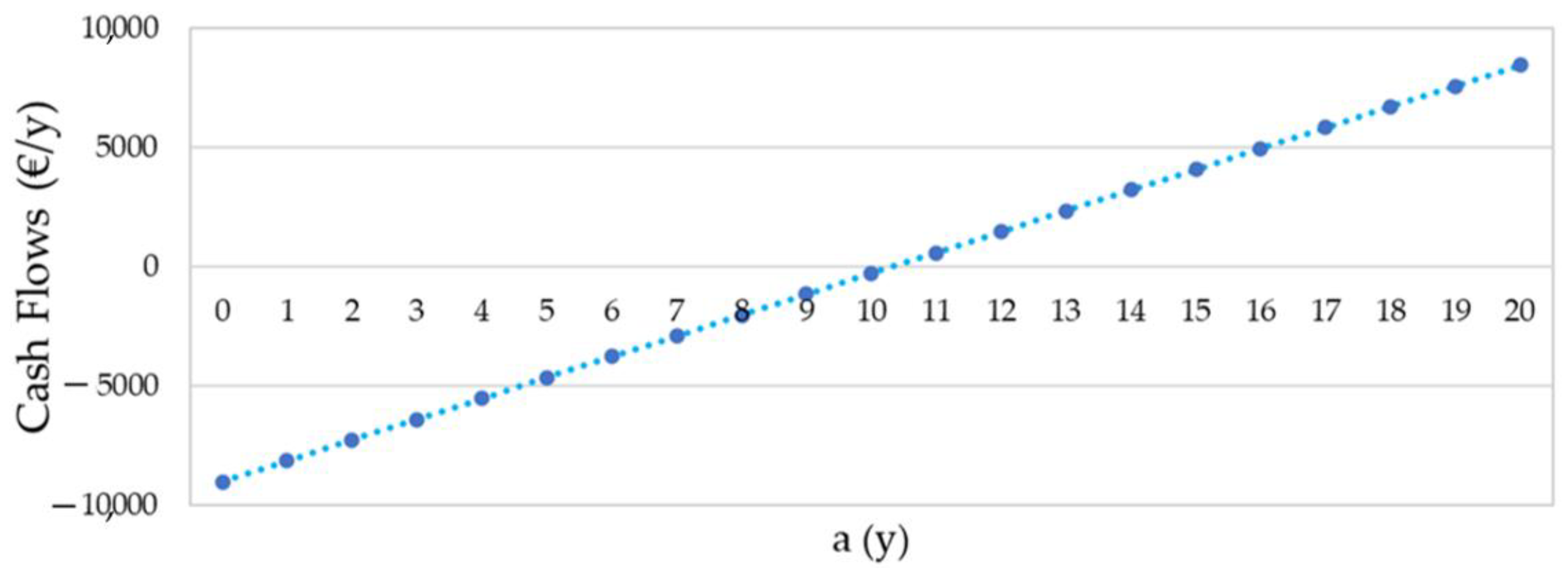
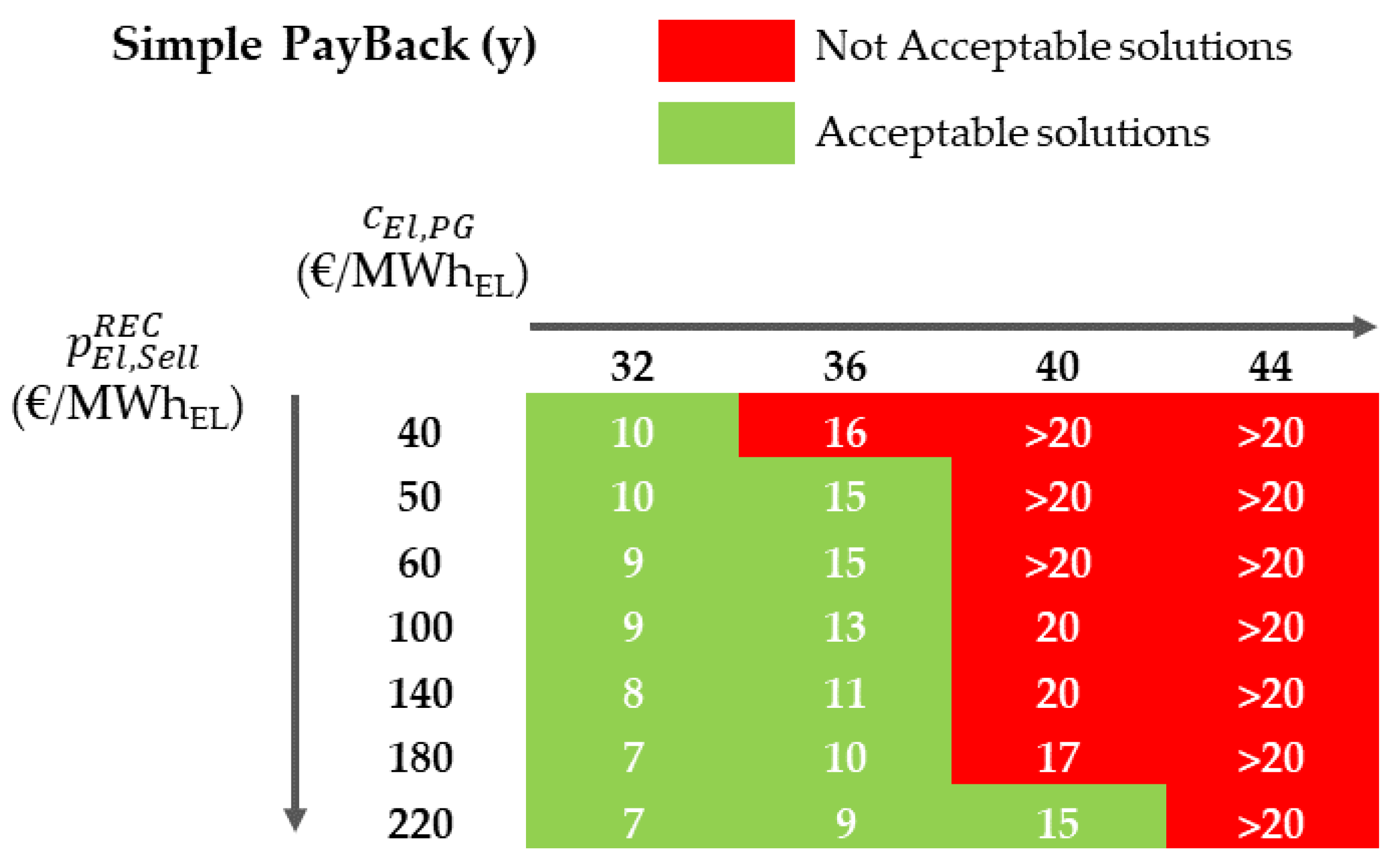
| Characteristics | Unit | R#1 | R#2 | R#3 |
|---|---|---|---|---|
| Area and volume ratio | (m−1) | 0.66 | 0.66 | 0.70 |
| External wall transmittance | (W∙m2∙K−1) | 0.61 | 0.61 | 0.82 |
| Roof transmittance | (W∙m2∙K−1) | - | 0.70 | 0.95 |
| Inter-floor slabs transmittance | (W∙m2∙K−1) | 0.93 | - | - |
| Ground floor transmittance | (W∙m2∙K−1) | - | - | 1.24 |
| Window transmittance | (W∙m2∙K−1) | 3.4 | 3.4 | 3.7 |
| g-value | (-) | 0.76 | 0.76 | 0.76 |
| EHP | Cooling Power (kWCo) | Heating Power (kWth) | EER (-) | COP (-) |
|---|---|---|---|---|
| EHPR#1_1 EHPR#1_2/EHPR#1_3 | 5.2 | 6.0 | 3.68 | 4.0 |
| 2.6 | 3.2 | 4.0 | 4.0 | |
| EHPR#2_1 | 4.3 | 4.9 | 3.3 | 3.75 |
| EHPR#2_2/EHPR#2_3 | 2.5 | 3.15 | 3.6 | 4.2 |
| EHPR#3_1 | 4.2 | 4 | 3.75 | 4.04 |
| EHPR#3_2 | 3.4 | 5.4 | 3.75 | 4.12 |
| Parameter | Value |
|---|---|
| Peak power (kW) | 0.15 |
| Solar panel efficiency (%) | 14.4 |
| Rated working voltage (V) | 22.5 |
| Rated working current (A) | 8.25 |
| Open circuit voltage (V) | 18.2 |
| Short circuit current (A) | 8.87 |
| Nominal operating cell temperature (°C) | 45.0 |
| Maximum power temperature factor (%/°C) | −0.46 |
| Temperature coefficient of current (%/K) | 0.06 |
| Gross area (m2) | 1.69 |
| Economic/Social Index | R#1 | R#2 | R#3 |
|---|---|---|---|
| (EUR/y) | 1663.0 | 1198.8 | 1407.2 |
| (EUR/y) | 905.2 | 796.4 | 362.1 |
| (EUR/y) | 2568.2 | 1968.3 | 1769.3 |
| (EUR/y) | 45,000 | 20,000 | 26,800 |
| (EUR/y) | 39,000 | 18,000 | 17,000 |
| (%) | 5.71% | 9.84% | 6.60% |
| (%) | 6.59% | 10.93% | 10.41% |
| Parameters | Symbol | Unit | Value |
|---|---|---|---|
| Investment cost PV | ICPV | EUR | 18,000 |
| Maintenance cost of PV | MC | EUR/y | 1800 |
| Year of incentive | a | y | 20 |
| Percentage of ICPV covered by economic mechanism support | f | % | 50 |
Publisher’s Note: MDPI stays neutral with regard to jurisdictional claims in published maps and institutional affiliations. |
© 2022 by the authors. Licensee MDPI, Basel, Switzerland. This article is an open access article distributed under the terms and conditions of the Creative Commons Attribution (CC BY) license (https://creativecommons.org/licenses/by/4.0/).
Share and Cite
Ceglia, F.; Marrasso, E.; Samanta, S.; Sasso, M. Addressing Energy Poverty in the Energy Community: Assessment of Energy, Environmental, Economic, and Social Benefits for an Italian Residential Case Study. Sustainability 2022, 14, 15077. https://doi.org/10.3390/su142215077
Ceglia F, Marrasso E, Samanta S, Sasso M. Addressing Energy Poverty in the Energy Community: Assessment of Energy, Environmental, Economic, and Social Benefits for an Italian Residential Case Study. Sustainability. 2022; 14(22):15077. https://doi.org/10.3390/su142215077
Chicago/Turabian StyleCeglia, Francesca, Elisa Marrasso, Samiran Samanta, and Maurizio Sasso. 2022. "Addressing Energy Poverty in the Energy Community: Assessment of Energy, Environmental, Economic, and Social Benefits for an Italian Residential Case Study" Sustainability 14, no. 22: 15077. https://doi.org/10.3390/su142215077
APA StyleCeglia, F., Marrasso, E., Samanta, S., & Sasso, M. (2022). Addressing Energy Poverty in the Energy Community: Assessment of Energy, Environmental, Economic, and Social Benefits for an Italian Residential Case Study. Sustainability, 14(22), 15077. https://doi.org/10.3390/su142215077







